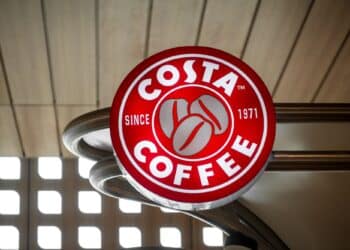The coffee industry has witnessed record-breaking acquisitions over the past decade, with several deals exceeding the billion-dollar mark. What’s driving these mergers, and will continued market volatility see further consolidation in the coffee sector?
When Coca-Cola purchased European café group Costa Coffee in 2018 for US$5.1 billion, the then record-breaking acquisition was in the media for months. Journalists from New York to Norway, in places that had never hosted a Costa Coffee store, followed the story and made their predictions on the global beverage giant’s multi-billion-dollar “bet”.
The deal was Coca-Cola’s biggest ever acquisition of a brand and was said to be influenced by consumers’ shift away from sugary drinks, compounded by the continued growth of coffee consumption.
At the time, Costa Coffee was the United Kingdom’s largest coffee chain, with more than 2400 domestic outlets and 1400 additional venues in other markets across Europe and Asia. The announcement of the deal in August 2018 came less than a year after Nestlé’s purchase of United States (US) specialty roaster Blue Bottle Coffee for about $425 million, which also got industry pundits talking.
Other significant acquisitions over the past decade include De’Longhi spending $374 million to acquire a 41.2 per cent stake in Italian espresso machine brand La Marzocco in 2023, two years after purchasing the remaining 60 per cent stake in Swiss coffee machine manufacturer Eversys for $164 million; and JAB Holdings’ buyout of the UK’s Pret A Manger for $2 billion in 2018.
Of course, not all these mergers are headline-making, billion-dollar deals. Every day around the world, mid-size coffee-aligned companies take over smaller companies. It’s part of a broader trend of consolidation within the industry that’s being driven by a number of factors, such as saturation in mature markets.
In places like Europe where demand is plateauing, bigger companies are growing market share by absorbing the competition rather than relying on organic growth. An interest in pursuing new trends and reaching younger demographics has also seen established brands venturing out of their lanes to explore fresh opportunities.
An unlikely partnership An unlikely acquisition that made headlines in 2023 was Chobani’s purchase of La Colombe Coffee Roasters for $900 million. While the US-established Greek yogurt brand had previously invested in the coffee category with the introduction of creamers, La Colombe’s experience in the ready-to-drink (RTD) market was a key driver in the investment.

“By bringing La Colombe into the Chobani family, the brands increased opportunities to bring delicious, high-quality cold brew and ready-to-drink craftsmanship to a next generation of consumers,” a Chobani spokesperson tells Global Coffee Report.
Before making the leap, Chobani’s research had identified opportunities for growth in the chilled coffee sector.
“Younger coffee drinkers are fuelling growth in the cold coffee market, resulting in RTD coffee consumption rising 43 per cent between 2019 and 2023. While La Colombe is known for its quality roasted beans and coffeehouse experience, cold coffee is its cutting edge,” says the spokesperson.
“Consumers seek more convenient snacks and beverages, along with less sugar and more functionality. By combining forces, we expect more brand innovation and accessibility that will transform the RTD coffee category.”
For now, La Colombe continues to operate as a separate brand while being part of the Chobani family. According to Chobani, the acquisition marked another step in its journey to become “a next generation food and beverage company”.
“The acquisition provided us with a strong and differentiated offering in a category that is poised for disruption,” says the spokesperson.
“While celebrating its heritage, La Colombe is focused on pioneering the future of ready-to-drink coffee and the café experience. Chobani’s pursuit to provide coffee lovers with nutritious and natural creamers complements this focus on pioneering the coffee industry with healthier, more delicious products.”
Brewing the next generation of technology Like Chobani, Simonelli Group saw acquisition as a route to tap into a sector of the industry it didn’t yet have the infrastructure to cater to. In December 2024, the espresso machine manufacturer purchased a stake in Swedish coffee filter machine company 3TEMP to expand its portfolio and strengthen its position in the growing specialty coffee market.
“As consumer demand grows for specialty and premium drip coffee, Simonelli Group saw in 3TEMP a partner with deep expertise in filter brewing and a proven track record of cutting-edge solutions. The brand’s unique tank-less brewing technology and sustainability-driven approach aligned perfectly with our strategic goals and innovation mindset,” says Marco Feliziani, CEO of Simonelli Group.
“The coffee landscape is evolving rapidly, and filter brewing is experiencing big growth, especially in specialty coffee markets. By investing in 3TEMP, Simonelli Group is expanding its portfolio to meet a wider range of consumer preferences and better serve professionals and coffee enthusiasts globally. Through this partnership, we aim to explore the extractions of the future – hot, cold, and concentrate are just the beginning.”
Through the acquisition, Simonelli aims to help 3TEMP scale its brewing technologies globally.
“This collaboration is designed to accelerate growth, deepen market presence, and raise the standard of batch brewing through sustainable, high-performance solutions,” he says.
“We also want to enable the team to stay focused on what they do best: building advanced filter coffee machines.”
With Simonelli Group’s aspirations set on growth, Feliziani says when looking for new partners the company prioritises those that share its relentless drive for innovation, quality, and sustainability.
“In 3TEMP, we found a team deeply committed to technical excellence, creative brewing solutions, and a strong understanding of coffee extraction and knowledge. The decision to invest was driven by the alignment in values and a mutual ambition to shape the future of coffee preparation,” he says.
“Simonelli Group is positioning itself to lead in a fast-evolving industry by building an integrated ecosystem that can swiftly respond to market trends and consumer needs. This strategic direction can suggest further growth via partnerships or investments remains a likely path.”
More consolidation on the menu? Growth is the aim of the game for coffee businesses, yet recent challenges including volatile green-bean prices, supply issues due to conflict, and shifting consumer preferences have made that goal increasingly difficult – especially for smaller setups with less purchasing power.
As some coffee businesses struggle, some experts believe we’ll see increased market consolidation over the next few years.
“There are many consolidation deals every year, but the majority are on a small scale – it’s not always the big guys like Nestlé, JDE Peet’s, and Lavazza signing billion-dollar agreements,” says international coffee consultant and former Nestlé Executive Gerd Mueller-Pfeiffer.
“Due to increasing green-bean prices over the past year, many coffee companies are running their P&L near to the zero line and running into financial trouble.
“Bigger companies use this opportunity to buy struggling companies to gain a larger footprint in order to gain more scale and purchasing power. I do believe there will be more consolidation.”
While every business deal carries risk – especially billion-dollar takeovers – mergers and acquisitions can help businesses to reduce costs through shared logistics, procurement, and marketing. It also gives the brand more bargaining power with both suppliers and distributors.
Although Mueller-Pfeiffer forecasts more consolidation in the coffee industry’s near future, he doesn’t believe coffee will follow the path of some sectors in which only five or six giants control the market.
“If you think about it, there are only a handful of companies that could have that much power: JDE Peet’s, Nestlé, Lavazza, Starbucks, and potentially Coca-Cola. Nestlé is focused on its core brands such as Nespresso and Nescafé, while Starbucks is concentrating on the home market and some geographical expansion such as China and the Middle East,” he says.
“JDE Peet’s has tried to do it, but the financial results just aren’t there. They have attempted to do too many things in a short period and not integrated enough, which causes complexity. I don’t believe we’ll end up in a situation in which several major players will dictate coffee.”

Although it’s often the deals involving consumer-facing brands such as Costa Coffee and Blue Bottle Coffee that make the news, acquisitions have been taking place right across the supply chain. Green bean trading is one segment that Mueller-Pfeiffer believes will see continued consolidation.
“Due to the financing model of merchants, some are experiencing financial problems because they’re not running on a strong P&L. Due to the structure of the business model, even some of the larger organisations are struggling,” he says.
“We’ll see more direct models of coffee trading, with more producers skipping the middleman and distributing products directly into consumption countries.”
But what does more consolidation mean for the coffee industry – will less choice result in higher prices for consumers, and what happens to creativity within the sector?
“Can consolidation be positive for the greater good of the coffee industry? Sometimes yes, but quite often no,” says Mueller-Pfeiffer.
“As a consumer, you could be confronted with higher pricing from venues due to the fact they have less competition. The beauty of the coffee industry is having the local coffee shops, the local ideas, and the local tastes.”
For the team at Chobani, consolidation is a natural part of the sector and a vehicle for growth and new opportunities.
“Consolidation is nothing new in the coffee industry,” says the spokesperson. “La Colombe operated independently for nearly 30 years, but by joining forces with Chobani, the brand now has the resources to scale ready-to-drink operations while simultaneously perfecting the café and hospitality experience the community has grown to know and love.”
Only time will tell whether this consolidation trend will continue or if independents will see a re-emergence.
This article was first published in the September/October 2025 edition of Global Coffee Report. Read more HERE.





